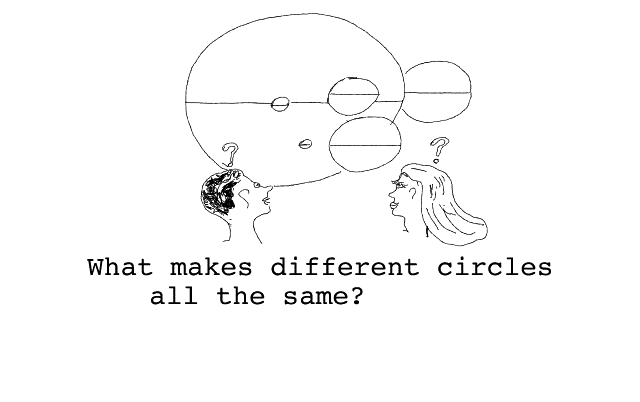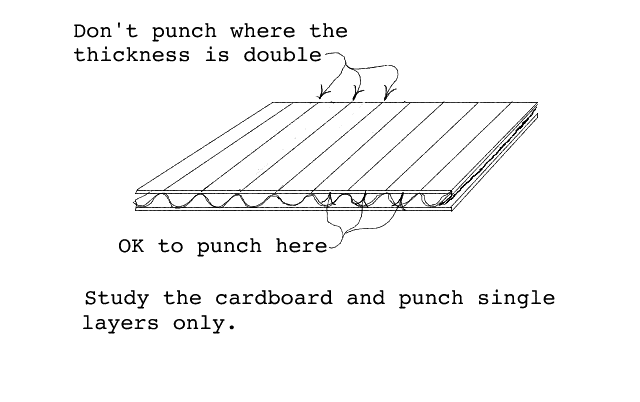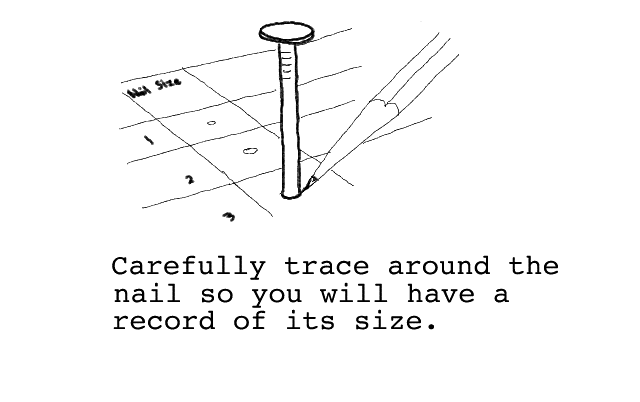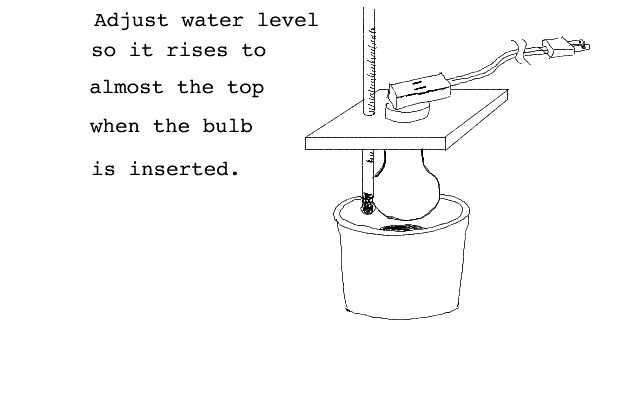
(The following "Student instruction sheet" will be divided into three separate sheets since each of the concepts we are discussing: pi, pressure and power, can really be treated as separate topics. We hope you remember that the reason we lumped these three concepts was because they represent ideas that everyone seems to "know", but when quizzed, there is little real understanding. It has been our experience that few students, even at the college level, can give clear and accurate definitions of any one of these three concepts.)
The amazing truth about all circles.
When you look at a circle, it looks like a circle! When you look at big circles and small circles they all look pretty much the same, except for their size. Many centuries ago it was discovered that not only did all circles look alike, there was something else that was the same about all circles. This special "sameness of all circles" is what we are going to investigate in this experiment.

Your teacher will have supplied you with all sorts of different circular objects. You will have to work out a way to measure the distance around the outside of each circular object (this is called the circumference) and the distance straight across the object in its widest place (this is called the diameter.) You will take careful data on as many objects as you can. So that you will always know which object you are talking about, it is a good idea to record the number each object has been tagged by your teacher as well as giving a brief description of the object. A data table like the following should be made:
|
Tag # of object |
Brief description of object. |
Circumference |
Diameter |
|
|
|
|
|
|
|
|
|
|
|
|
|
|
|
After you have taken as much data as you can on as many different sized object as possible, you are going to study this data and do some special calculations with it to see if you can find the amazing truth about all circles. Your teacher might give you some hints on how to proceed.
When you study and make computations with your data, you must remember that all measurements have some error. Every scientist knows that her/his measurements are never perfect so when the final conclusions are drawn from the data, measurement errors must always be taken into consideration. One of the hardest things a good scientist must decide when given lots of data is: How much of this is useful to me in forming my conclusions and how much can be ignored as experimental error? In this experiment you are searching for one of the really big ideas about circles that was discovered many centuries ago. As you look at your data and make calculations with it, you probably will not get perfect results. Yet a good scientist learns how to look at data and how to decide when the data is useful and when it is garbage. The "truth" is hiding inside all of that data and it becomes your task to find it.
Be sure to compare your data and results with other students. Do you all come to the same conclusion? If you come to a different conclusion, do you think the "truth" is different for each student or do you think the "truth about circles" is the same and the different conclusions are due to different skills and abilities of each individual student?
What is the difference between Pressure and Force?
Racing bicycle tires are maintained at a very high pressure. The tires on the average car are maintained at a much lower pressure. Everyone knows that cars weigh much more than bicycles and this means that a car must exert a larger force on the ground than a bike. The pressure inside of a racing bicycle tire can be over 100 pounds per square inch yet the entire bike might weigh less than 20 pounds. The confusion here has do do with the difference between force and pressure and this activity should help you to understand this difference.
You will be given several different sized nails with their points cut off. You will use these nails to try to punch holes through the top layer of a piece of cardboard. But before you begin you should take a close look at a piece of cardboard so you will understand how it is constructed.

If you were punching a hole through just the top layer of the cardboard, you must be careful to punch only where there is a single layer. Study the cardboard and mark places where you can punch through it and only be punching through a single top layer.
The nails you will be given will be tagged and all nails of the same size will have the same number. Make a data sheet like the following to record your experimental results:
|
Nail tag # |
Sketch of nail size |
Description of force to punch through. |
|
|
|
|
|
|
|
|
|
|
|
|
Since it is hard to measure the diameter of the nail, we are going to record the size of the nail by using a sharp pencil to trace a little circle around the end of the nail. This sketch on your data sheet will help to remind you of the size of the nail.

Scientists prefer to make measurements using instruments like thermometers and rulers since they don't have to trust their judgment only, to get results. However, sometimes when they don't have a proper instrument, they will try to make an honest guess or estimate about the measurements they make. In this experiment you are going to estimate how much force it takes to push the nail through a single layer of cardboard. You will record statements like: "easy" or, "hard" or, "very hard", etc. Try to judge the strength of the force as honestly as you can and perhaps have another student in your group make his or her measurements without knowing what you got and then compare your results to see if you agree.
When you punch the nail through the cardboard, try to punch straight through. If you rock the nail around, the edge will cut through. You are to attempt to punch the nail through with the entire area of the flat part of the nail in contact with the cardboard. You should notice that with some of the nails it is very hard to push them through and with others it is not so hard.
Take data as you punch the nails through the cardboard and then do the experiment again to see if you get about the same results. A good experiment can be repeated with nearly the same results. This experiment might not be very good since we really don't have special instruments which make repeating the measurements easy. Do the best you can and most of all, be honest. Repeating the experiment may cause you to change your mind. Changing your mind can be a good thing if you have good evidence to cause you to change your mind.
Your teacher should discuss with you the difference between force and pressure. After this discussion, try to make a conclusion about the force and the pressure necessary to push different sized pointless nails through wood or cardboard.
Special exercise on force and pressure.
You know how much force you exert when you stand on the floor, it's simply your weight. If you know how much you weigh in pounds, then the force you exert on the floor is simply your weight in pounds. But how much pressure do you exert when you stand on the floor. Will it make a difference if you stand on one foot or two? Will a lady with high healed shoes exert the same pressure as she did when she wore flat shoes? What if she puts all of her weigh on the heal of one of her high healed shoes?
In this exercise you are going to determine how much pressure you exert on the floor when you stand on one foot. Since in the US we almost always measure pressure in pounds per square inch, we will use US units in this exercise. Later, if you wish, you can do the exercise in metric units. Here is what you must do:
1) Measure your weight in pounds. (If you know it, you won't have to step on a scale.)
2)Measure the area of the bottom of your shoe in square inches. (How are you going to do this? If you did the earlier experiment on area, you should already know. You will need to trace the bottom of your shoe on to a piece of paper and use a ruler to make one inch squares.)
3) Since pressure is force divided by area, take your weight in pounds and divide by the area of the bottom of your shoe in square inches.
Something to think about: Do you think girls or boys exert more pressure when they stand on the floor? What about adults compared with children? The pressure under the heal of a woman's spiked heal can be quite large. How would you find out how much pressure a woman could exert if she stood with all of her weight on one of the heals of a pair of spiked shoes?
Measuring the Power of a light bulb.
Light bulbs come in all different sizes and power ratings. The small lights on a Christmas tree may be only 5 watts yet the vary large bulbs used in the lamps for lighting a football field can be 1000 watts or more. Even light bulbs that look the same on the outside can have a wide range of power or "wattage" ratings. Power is work or energy per time and this means that a light bulb gives out energy at a rate which will be larger if the wattage of the bulb is large. You can measure the energy a light bulb puts out by using it to heat water. In this experiment you are going to study how fast different wattage bulbs can heat the same amount of water.
It is important that you follow the instructions given by your teacher carefully. If you know what you are doing, mixing water and electricity can be quite safe. However, this experiment can be dangerous if not done carefully.
The apparatus for this experiment is shown below. If different groups are to do the experiment, it is important that every group have exactly the same amount of water in the cup. Your teacher will instruct you as the the exact amount of water to use.

After your group has prepared the apparatus for the experiment, your teacher will plug in the extension cord to start the experiment. You must record the temperature just before the experiment starts and keep track of the time while the temperature changes. It is a good idea to record the time and temperature while the water is heating. One member of the group should gently shake the cup to stir the water while it heats. Be sure to note the time when the desired temperature change has taken place (your teacher will tell you how much the temperature should change) and then have your teacher unplug the extension cord.
You may not need all of the following data for this experiment but it is always a good idea to record as much information as is convenient. You never can tell when some information might turn out to be useful.
Suggested Data:
Amount of water in the cup:_________________
Wattage of the light bulb used:_________________
Temperature of water when power was plugged in:_______________
Time when power was plugged in:___________________
Temperature of water when power was disconnected:_________________
Time when power was disconnected:________________
Although it is not required, you might want to make a data table that keeps track of the time and temperature while the water is being heated. The important thing to record, however, is the time and temperature at the beginning and the time and temperature at the end of the experiment. If all groups have the same amount of water and you all agree to shut off the power when the same amount of temperature change has taken place, it will be possible for you to compare the effective power of the different light bulbs.
Special problems to consider:
1) Power is work per time, this means that work is power times time. It takes energy to keep the lights running in your home and someone has to pay for it. If 1000 watts runs for one hour, this is a unit of energy called the "Kilowatt hour". See if you can get a copy of the electric power bill for one month's usage at your home and see how may Kilowatt hours your family uses in one month.
2) All appliances as well as light bulbs will have the power they use in watts written on them somewhere. Check the appliances in your home for their wattage ratings. Which ones do you think cost the most to run per month? Remember, power isn't the only thing to consider. How long they will keep running is important too! For example, a vacuum cleaner uses more power than a TV set but, which one do you think uses the most energy per month?
Back to general background discussion of pi, pressure and power.
Back to teaching suggestions for the presentation of concepts realted to pi, pressure and power.